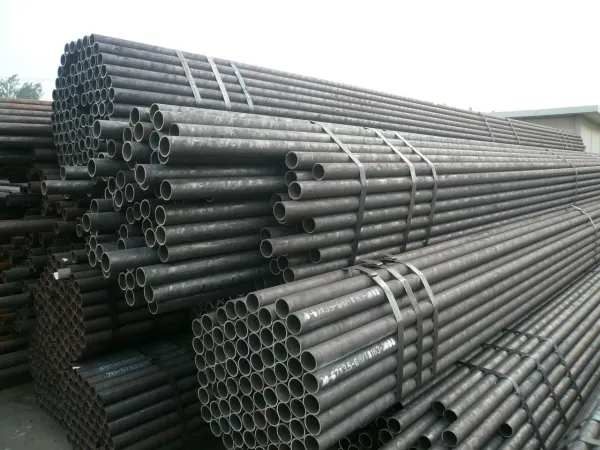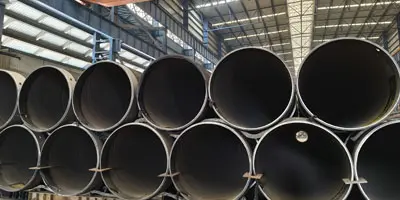1.What Is Schedule 20 Carbon Steel Pipe?
Schedule 20 Carbon Steel Pipe is made primarily of carbon and iron, with carbon being the dominant material, comprising about 90% of all steel used globally. These pipes are widely used for low-pressure applications and are known for their light weight, making them suitable for a variety of industries. The term "Schedule" refers to a standardized measure of wall thickness, outer diameter, and bore size, and Schedule 20 is one of the lower schedules, designed to withstand mild pressures in a range of applications.Schedule 20 is a very common wall thickness specification for steel pipes. Sch20 is a representation of the American standard steel pipe size and belongs to the British pipe wall thickness series. Widely used in petroleum, chemical and other fields.Compared with the pipe of sch40, sch80 and other specifications, the pipe of this specification has a different outside diameter and belongs to the thin pipe wall series. It has lower weight and higher fluid transfer efficiency, while also sacrificing bearing capacity to a certain extent.
2.What is Carbon steel pipe?
Carbon steel pipe is the most common use piping material in different industries served for construction, structural, liquid transmissions for water, oil and gas. Typical carbon steel pipe material grades in API 5L Grade B, X42 to X70, ASTM A106 B, ASTM A53 B, ASTM A252 Grade 3 and ASTM A333 Grade 6 etc.Carbon steel pipes are widely used in various applications due to their strength, durability, and cost-effectiveness. They are made primarily from carbon and iron, with varying carbon content that affects their properties.Baowi steel offers various of carbon steel pipes including seamless, welded (ERW EFW, LSAW, SSAW) steel pipes for the mining industries
3.What Does “Schedule 20” Mean in Pipe Standards?
The "Schedule" number indicates the thickness of the pipe's walls. For Schedule 20 Carbon Steel Pipes, this schedule is specifically designed for low-pressure systems. The pressure rating of the pipe depends on its dimensions: smaller diameters with thicker walls have higher pressure tolerance, while larger diameters with thinner walls are rated for lower pressure levels. The Schedule 20 pipe pressure rating is crucial for determining its suitability in various industries, ensuring it can handle specific pressure loads without risk of failure.
4.Schedule 20 Steel Pipe Production Standards
Schedule 20 steel pipe production follows a range of international and regional standards, including but not limited to:
ASME B36.10: This standard specifies the dimensional standards and tolerances of steel pipes in detail.
ASTM A53: Strict requirements for the chemical composition and mechanical properties of carbon steel tubes for pipes.
DIN 2448: A German industry standard that specifies the dimensions and tolerances of seamless steel pipes.
5.Key Features and Material Characteristics of Schedule 20 Carbon Steel Pipe
Material Composition:
Schedule 20 Carbon Steel Pipe is made of carbon and iron, providing strength and durability for low-pressure systems.
Wall Thickness:
The wall thickness ranges from 6.35 mm to 12.7 mm, influencing the pipe's pressure tolerance and weight. Thicker walls handle higher pressures, while thinner walls are suitable for lower-pressure applications.
Nominal Size:
Available in sizes from 8 inches to 36 inches, making it adaptable for various low-pressure applications.
Pressure Rating:
These pipes are designed for low-pressure systems, with pressure ratings depending on wall thickness and diameter.
Material Options:
In addition to carbon steel, low alloy steel and stainless steel options are available for specific needs.
Mechanical Properties:
The pipes meet industry standards for elongation, yield strength, and tensile strength, ensuring reliability in low-pressure systems.
Weldability:
Schedule 20 carbon steel pipes are easy to weld, using methods like arc welding or TIG welding for secure connections.
Surface Quality:
The pipes have a smooth, defect-free surface, ensuring durability and suitability for welding and coating processes.

6.Schedule 20 Pipe Carbon Steel Pipe Manufacturing Process
Sch20 seamless steel pipe manufacturing process is mainly hot rolling, cold rolling and hot extrusion.
Hot rolling
The billet heated at high temperature is perforated by a perforator to form a capillary. Then, the capillary goes through multiple rolling, sizing and reducing, and finally gets the seamless steel pipe that meets the specifications.
Cold rolling and hot extrusion
It is mainly used to produce seamless steel pipes with high precision and high surface quality. The steel pipe after hot rolling is reprocessed by cold rolling process to improve dimensional accuracy and surface finish. Hot extrusion is the process of forming billets through a die at a high temperature. Improve mechanical properties and surface quality of products.
7.Schedule 20Carbon Steel Pipe Application Area
SCH 20 pipingis suitable for low pressure working environments. Commonly used for:
Water supply and drainage systems: such as fire protection systems and certain industrial cooling water circulation systems.
Oil and Gas: The sch20 pipeline serves as an auxiliary pipeline for media such as fresh water and nitrogen in oilfield water injection systems, natural gas distribution stations, and small liquefied natural gas (LNG) storage facilities.
Food processing and pharmaceutical industry: sch20 pipeline can meet the requirements of corrosion resistance after surface treatment such as galvanized, responsible for the transportation of raw materials and semi-finished products
8. Schedule 20 Carbon Steel Pipe chart gives dimensions of schedule 20. Chart includes sizes in inches and in millimeters.
|
Nominal size [inches]
|
Outside diameter [inches]
|
Outside diameter [mm]
|
Wall thickness [inches]
|
Wall thickness [mm]
|
Weight [lb/ft]
|
Weight [kg/m]
|
|
8
|
8.625
|
219.1
|
0.25
|
6.35
|
22.36
|
33.31
|
|
10
|
10.75
|
273
|
0.25
|
6.35
|
28.04
|
41.77
|
|
12
|
12.75
|
323.8
|
0.25
|
6.35
|
33.38
|
49.73
|
|
14
|
14
|
355.6
|
0.312
|
7.92
|
45.61
|
67.9
|
|
16
|
16
|
406.4
|
0.312
|
7.92
|
52.27
|
77.83
|
|
18
|
18
|
457
|
0.312
|
7.92
|
58.94
|
87.71
|
|
20
|
20
|
508
|
0.375
|
9.53
|
78.6
|
117.15
|
|
22
|
22
|
559
|
0.375
|
9.53
|
86.61
|
129.13
|
|
24
|
24
|
610
|
0.375
|
9.53
|
94.62
|
141.12
|
|
26
|
26
|
660
|
0.5
|
12.7
|
136.17
|
202.72
|
|
28
|
28
|
711
|
0.5
|
12.7
|
146.85
|
218.69
|
|
30
|
30
|
762
|
0.5
|
12.7
|
157.53
|
234.67
|
|
32
|
32
|
813
|
0.5
|
12.7
|
168.21
|
250.64
|
|
34
|
34
|
864
|
0.5
|
12.7
|
178.89
|
266.61
|
|
36
|
36
|
914
|
0.5
|
12.7
|
189.57
|
282.27
|
FAQs:
What is Schedule 20 Carbon Steel Pipe used for?
Schedule 20 Carbon Steel Pipe is commonly used in low-pressure applications such as water systems, HVAC, and plumbing where the pressure requirements are minimal.
What is the pressure rating of Schedule 20 Carbon Steel Pipe?
Schedule 20 Carbon Steel Pipe is designed to handle low-pressure systems, with pressure ratings depending on the pipe's wall thickness and size.
What sizes are available for Schedule 20 Carbon Steel Pipe?
Schedule 20 Carbon Steel Pipe is available in nominal sizes ranging from 8 inches to 36 inches, offering a variety of options for different applications.
How does Schedule 20 Carbon Steel Pipe compare to other schedules?
Compared to Schedule 40 and higher schedules, Schedule 20 Carbon Steel Pipe has a thinner wall and is used for applications with lower pressure tolerance.
Is Schedule 20 Carbon Steel Pipe suitable for outdoor use?
Schedule 20 Carbon Steel Pipe can be used outdoors but should be coated or treated for corrosion protection, especially in environments where it may be exposed to moisture or chemicals.
What is the wall thickness of Schedule 20 Carbon Steel Pipe?
The wall thickness of Schedule 20
Carbon Steel Pipe ranges from 6.35 mm to 12.7 mm, depending on the size and application requirements.






 English
English Español
Español بالعربية
بالعربية











 Phone :
Phone :  Whatsapp :
Whatsapp :  Email :
Email : 


